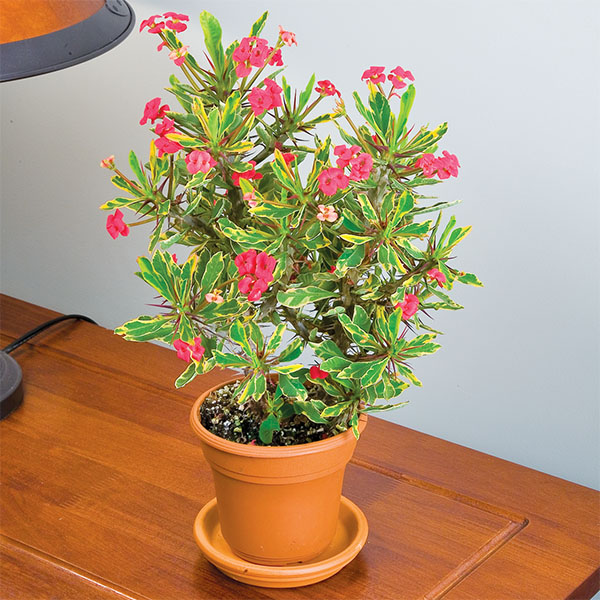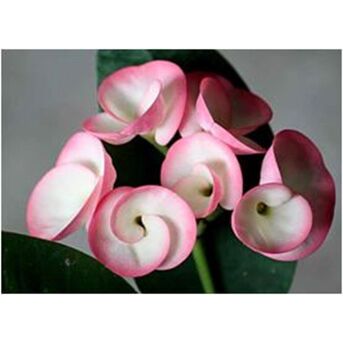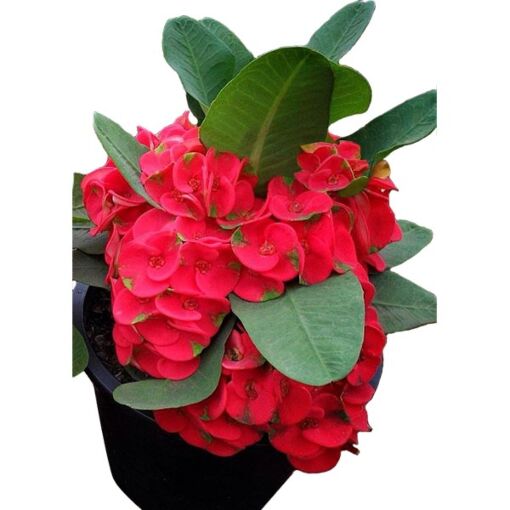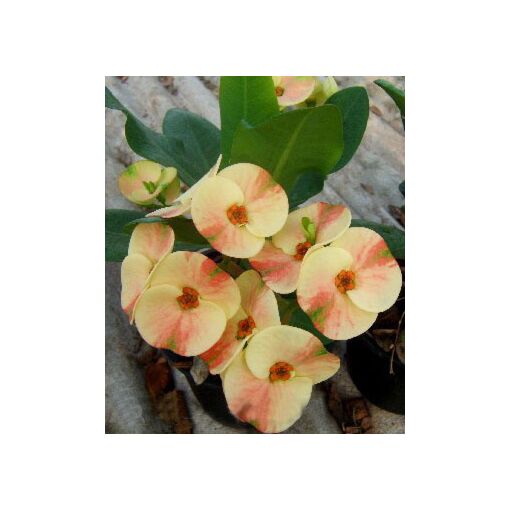
Crown of Thorns (Euphorbia hybrids)
These Indestructible Plants have Dazzling Colors and Bold Flowers
By Laurelynn Martin and Byron Martin
 |
| Crown of Thorns ‘Golden Gem’ |
Euphorbias have over 2,000 varieties and originate from South America, Africa and Asia. The Crown of Thorns type, which are hybrids of Euphorbia milii and Euphorbia lophogona have flowers that grow in clusters of brilliant blooms. They are considered indestructible because they can grow year-round on a sunny windowsill in a warm, bright location, tolerating long periods of dryness.
Euphorbias are also one of those tried and true houseplants that get passed down from generation to generation. Lately, there has been an effort, particularly in Thailand, to hybridize a dazzling array of colors and large sized blooms compared to the traditional species.
Why are they popular? Euphorbias have a reputation as a tough plant with surviving extreme cultural conditions and they still look good. From their ability to adapt to extreme dryness or to partial sun, Crown of Thorns are indestructible plants for gardeners of all experience levels.
 |
| Crown of Thorns ‘Paradise Lady’ |
They flower primarily during the spring and summer when the days are long and warm. Sometimes in tropical locations, or greenhouse situations, you’ll see sporadic flowering year round if the light level is high and the plants are kept in higher temperatures. They can take cool nights in the winter as long as the days are above 60°F but longer periods of cold temperatures will force them in to a resting period when they will drop their leaves even to the extent of becoming leafless. Long periods of dryness will do the same
Light:
Full sun, inside on a southern exposure windowsill or outside during the summer months, is best but they can adapt to partial sun for short periods of time.
Temperature:
Maintain temperatures above 60°F, preferably 65°F, as these plants thrive in warm temperatures. If grown under cool temperatures, in the 40’s and 50’s, keep the soil dry to prevent root disease. They are zone 9-10 plants and will be damaged when temperatures drop below freezing.
 |
| Crown of Thorns ‘Red Bouquet’ |
Humidity:
Generally, humidity is not a problem. They thrive under desert conditions, which can have high humidity during the occasional rains and very low humidity in the heat and sun of the dry periods.
Potting Mix:
Use a cactus mix or other coarse potting mix that has good drainage.
Watering:
Bring soil to a state of visual dryness between waterings. When watering, thoroughly saturate the soil until some water trickles from the bottom of the pot. Growing in a clay pot helps maintain a healthy root system. These plants don’t like wet feet. Don’t let the pot sit in a saucer of water.
Fertilize:
Fertilize every two weeks using 1⁄4 tsp of fertilizer per gallon of water. Use a balanced fertilizer like a 15-15-15 or a blooming fertilizer like 7-9-5. Discontinue during the winter months, especially under cool temperatures.
Flowering:
The new Thai Giant Euphorbia hybrids have much larger flowers than the standard euphorbias. Frequently these new hybrids have blooms that measure 1-2” across.
Prune:
Prune after the flowering cycle is completed to maintain size. For branching varieties, you can remove weak side shoots. Thai Giant hybrids tend to grow tall without many side branches. If desired, you can remove the top 3-4” inches of growth to encourage more lateral branching. Be careful of the white sap that flows when the plant is cut. This can irritate skin and eyes. If pruning is done in early spring to early summer, you can often root the tip of the plant that was removed and create a new plant.
 |
| Crown of Thorns ‘Dreamland’ |
Insect/disease:
Euphorbia is susceptible to root disease if the potting mix is kept too wet. Be sure to let the soil dry between waterings. Sometimes, euphorbias are susceptible to white fly and mealybugs if other plants in close proximity have them.
A Note of Caution: Please remember to be careful when handling Crown of Thorns because of their spiky stems and their milky latex sap can cause skin and eye irritation.
Click here to view our Euphorbia's

